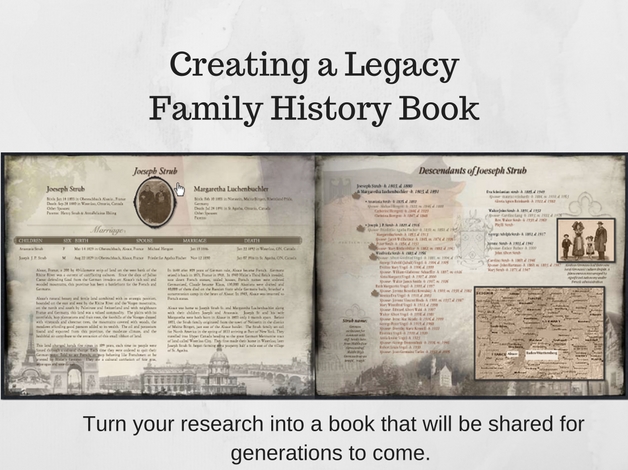In part one of our series Creating a Family History Book, we looked at identifying our dream of creating a family history book in 2018 along with recognizing our motivations behind the dream. I hope you took the time to identify your vision in specifics and to write it down using our template.
Now it’s time to move forward and to flesh out the eight milestone goals that will help you move closer to accomplishing that dream.
In my work of writing a family history book, I realized there are eight key goals that I had to meet along the way. I also realized it was essential to think and plan out each of those goals in advance before I began to write.
Let’s identify these 8 milestone goals. They will be your guide to creating a family history book. You won’t necessarily complete these goals in this order, but for the sake of planning your project, I recommend working through them in this order.
- Distribution of the Book – The first thing is to start at the end. How do you plan on selling and distributing the book? Who are you selling or giving the book to? What is your deadline for distribution? Do you wish to release the book at a specific event or in time for a milestone birthday or anniversary? Even if you don’t have an event to use as a deadline, it is best not to leave the publishing date open-ended. Always have a deadline to keep you on task.
- Printing the Book – Acquire quotes for printing of the book. You can have your book published online with any number of book publishers. My favourite is Createspace. You can check out my final product here. You can also take it to your local printer, or even your local office supply store can print it for you. But do your homework. Decide on a number of pages? Each page will cost more money. Will your book be colour or black and white? How will it be bound? Who will design the cover? How many copies do you need? How much time does the printer need? In what format does the printer require the manuscript? Set a deadline to get the manuscript to the printer, so it is back to you in time for your distribution deadline.
- Final Editing – Who will edit your book for you? It’s essential to have an outside editor. While you can rely on family and friends, you must be appreciative of their time and not expect a quick turn around. How much time will they need? Consider that several edits might be required. Set a deadline for each edit.
- Formatting – Scan pictures, documents, etc. for inclusion in the book. Choose font, spacing, cover design. Who will format the book? This could be the printer, yourself or someone familiar will book formatting like an editor. You may format your book in an online program such as Createspace or even in the writing software Scrivener. Once again, set a deadline for completion.
- Identify the Ancestors and their Stories – Identify the ancestors that you will write about. Create a list and gather and organize the research you require for each. Complete an ancestor profile which will help you to identify any missing gaps in your research and help you to get to know your ancestor better, before writing about them. Do you have enough research to tell a proper story? Organize all your research for this project into one place so that it is easily accessible. Some options include a computer file, Evernote, OneNote or Dropbox. Getting Ready to write. It important to establish a good workflow before beginning.
- Outline the Stories – Outline each of the stories for the ancestors you have identified. If your book is one story, then create a storyline and storyboard so that you have a plan for your writing. If you are writing several stories than you will want to create a storyline and storyboard for each story you plan to write.
- Schedule the Writing – Plan when, where and how you will write and complete the stories for your book. How much time will each story take? Identify how many words you can write in a given timeframe. How many words and can you write in an hour. How many hours to write first the first draft. How much time is required for revisions? Find the time to write and schedule it on your calendar. Create a deadline for a first draft and for completing revisions in time for the editor.
- Finalize the end Product – Now that you have worked through milestone goals 1 to 7 your vision for your book may have changed or altered a bit or drastically. That’s ok. Identify and rewrite your new vision for your product if it has changed.

What is A SMART Goal?
For each of these milestone goals, we want to make sure they are A SMART Goal. All goals should have the same common elements. They should be specific, measurable, actionable, realistic and have a target and we are going to add one more element, accountable making them A SMART Goal.
Let’s define each of these elements.
A- Accountable.
Who is going to keep you on task? Find an accountability buddy, or join a writing group. Somebody or some who will keep you focused on a regular basis for each of these milestone goals. They can be different people for each of these goals.
S – Specific.
Be as detailed as possible about what this goal is and what it will include. Write out the goal in specifics.
M- Measurable.
How will you measure your progress? Create a way of checking off or measuring your progress.
A-Actionable.
Each of these goals should be easily broken down into actionable tasks.
R-Realistic
Don’t take on more than you can chew. If you have never written a story before don’t start out by thinking you’re going to write an epic novel. Start out with short stories or ancestor profiles. Be realistic about your time and skills. If you’ve never written a story before taking a writing class might be a task you need to add to your project timeline.
T-Target.
Every goal should have a deadline, not just one overall deadline. These dates will keep you motivated and on task along the way.
Download our Milestone Goal Planner sheet to help you flesh out each of these milestone goals.
In Part 3, we will organize our Milestone Goals into an action plan to keep you focused and on task.
Creating a Family History Book in 2018
Part 1: Identifying Your Dream
Part 2: Fleshing out the 8 Milestone Goals
Part 3: Creating an Action Plan
Part 4: Establishing Daily Habits


